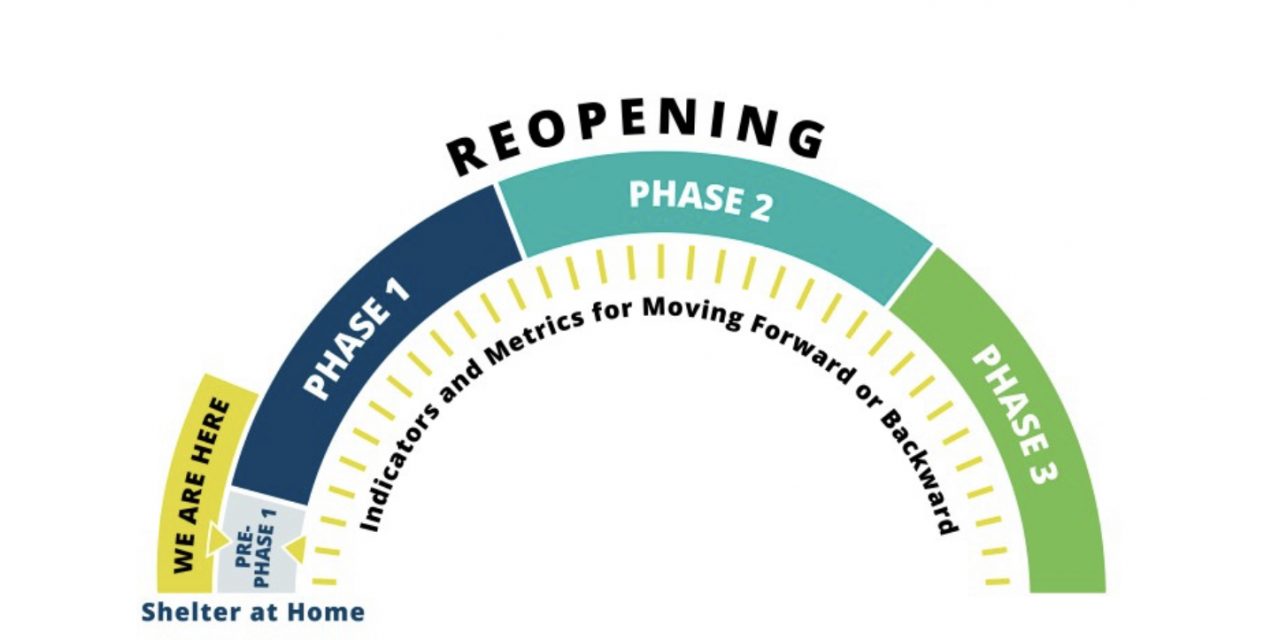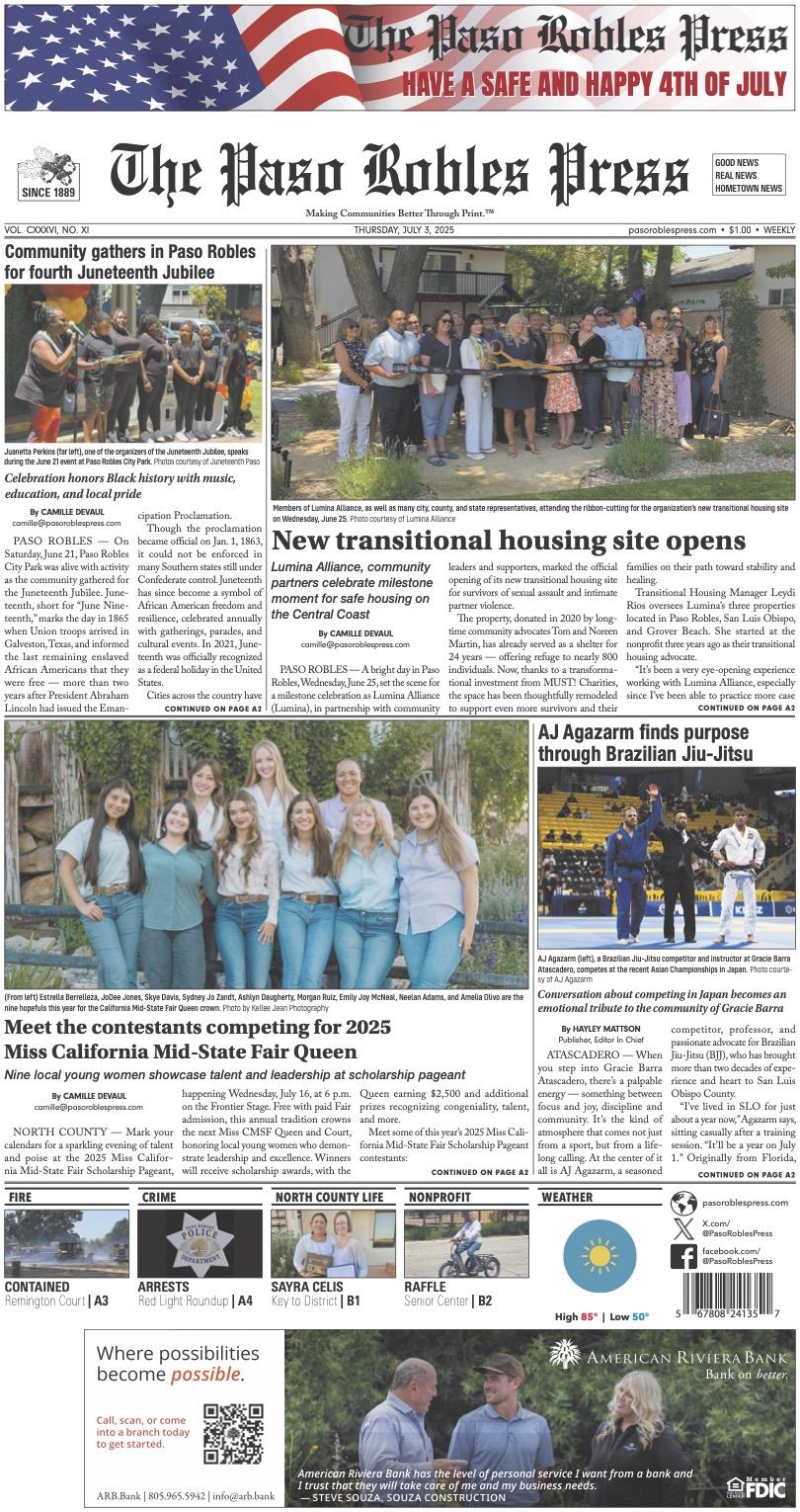The County will not begin Phase One of the START Guide until given State authority
On Friday, May 1, San Luis Obispo County made the START (Steps to Adapt and Reopen Together) Guide available to the public, and presented the guide at Friday’s public briefing from the Joint Information Center on Kansas Avenue in SLO.
“It provides a dynamic and responsive approach to reopen safely,” Borenstein said.
Borenstein explained its status as a “draft” that will be continually revised.
“We want to hear from the community in addition to the 600 comments we got from the various stakeholders,” Borenstein said. “There are things we may have missed and other ideas that may come forward to allow us to continuously edit and modify this document as we move forward.”
There are guidelines and standards, but not rules and protocols.
“I know we will have lots and lots of questions about whether it should be a ‘shall’ or a ‘must’ or a ‘may’ or a ‘should’ so what you will see in this document at this time is best practice guidelines,” Borenstein said.
The START Guide describes itself as drawn from three main sources for its framework:
- The Federal Government (Opening Up America Again)
- The State of California (Roadmap to Modify the Stay-At-Home Order and Update on the Pandemic Roadmap)
- Resolve to Save Lives (RSL), a global health initiative that describes the “adaptive response” to the COVID-19 pandemic.
Three unique factors to SLO County are considered factors of concern. Those factors are described as SLO County’s attraction as a tourist destination, college student migration, and lack of immunity among residents.
The START Guide defines three phases, which bring the local economy back to life. Each phase carries a graduated level of guidelines for individuals, businesses and institutions, and certain guidelines will carry through all the phases — good personal hygiene, physical distancing, protective equipment, sanitation and disinfectant, travel, home when sick, and protection of vulnerable populations.
According to Phase One of the START Guide, guidelines for individuals will call for vulnerable populations to continue to stay home and practice all current recommended distancing and masking. For the general public, phase one asks for a limit of 10 people gathering, and minimizing of nonessential travel.
For businesses and institutions, Phase One is broken into two parts — one part for all businesses and institutions, and one part for specific types of businesses and institutions.
For all businesses and institutions, reopening will begin with a call for strict operating standards for distancing, sanitation, hygiene, support for telework, supply of hand sanitizer or hand washing stations, consideration of special accommodations for vulnerable personnel, and minimizing of non-essential travel.
Specific guidelines in Phase One will apply to “general businesses” (e.g. retail, manufacturing, personal care), specific sectors (e.g. food facilities, movie theaters, museums, places of worship), K-12 schools, parks, playgrounds, and campgrounds, fitness (e.g. gyms, pools), beaches, outdoor activities, and healthcare – non-urgent surgeries and office visits.
The entire plan is constructed to work within the State framework, including the Six Indicators as presented by Governor Gavin Newsom. Loosening of restrictions are expected to be followed with tightening of restrictions when necessary to maintain control of the spread.
Along a projected timeline, when Phase One is able to begin, the framework of the START Guide follows as:
- Phase One of reopenings should take place in venues and environments that are subject to manageable protocols for physical distancing and other preventive measures.
- Phase Two can begin 30 days after initiation of Phase One if the criteria to ease restrictions have not worsened or if they have improved. Further loosening of restrictions may include partial or phased reopenings not covered in Phase One, and further easing of restrictions on institutions covered in Phase One.
- Phase Three can begin 30 days after initiation of Phase Two if the criteria to ease restrictions have not worsened or if they have improved, or alternatively, if a vaccine becomes available and widely administered locally. In this Phase, all institutions and businesses reopen, and most types of gatherings may recommence. Physical distancing in Phase Three may also be eased.
The County committed that the information in the START Guide is a “draft” and subject to revision as information and data changes — the public was invited to provide information to the County for review as the drafts change to meet the existing needs and factors as they relate to SLO County businesses, institutions and individuals.
The full information available from the County can be found here.
“From the outset of this pandemic, we did not wait for the State to act and through this we are staying one step ahead,” “We acknowledge there are differences between the Governor’s guide and our START Guide. We have always said we are preparing to lift our order, and we will reopen as soon as we can. We have been dialoguing with folks at the state to make our case.”
“One component of the guide you will see is a checklist of the six indicators laid out by the state to modify the Stay-At-Home order at the State level, and we feel we have met every one of those metrics,” Borenstein said.
The State’s Six Indicators were presented on April 14, as follows:
- The ability to monitor and protect our communities through testing, contact tracing, isolating, and supporting those who are positive or exposed;
- The ability to prevent infection in people who are at risk for more severe COVID-19;
- The ability of the hospital and health systems to handle surges;
- The ability to develop therapeutics to meet the demand;
- The ability for businesses, schools, and child care facilities to support physical distancing; and
- The ability to determine when to reinstitute certain measures, such as the stay-at-home orders, if necessary.
SLO County officials and representatives submitted a request to the state that the county efforts and results be recognized as evidence of responsibility and health, and called for the authority to begin reopening. Counties and cities are beginning to push back on orders by the Governor — Modoc County plans to lift its shelter order in violation of the State order, and Huntington Beach and Dana Point have filed injunctions against the state for the order to close Orange County beaches.
So far, SLO County has pushed ahead with plans to reopen while maintaining compliance with the State orders.
To accommodate for the first of the six indicators, SLO County has engaged with a state contractor to provide two new public testing sites.
Borenstein released information regarding the locations of the public testing sites — one at the Paso Robles Veteran’s Hall and another at Ramona Gardens Community Center, Grover Beach. Those testing sites will open and operate Monday through Friday from 7 a.m. to 7 p.m. Appointments can be made at readyslo.org or by calling 888-634-1123.
In answering questions, Borenstein made a broad statement regarding schools in SLO County.
“I can guarantee that no school is reopening for this school year,” Borenstein said.
She also addressed the question as to why SLO County does not mandate face masks and coverings in all public settings.
“There is no good information on whether masks help against this disease,” Borenstein said.
Borenstein explained that there are considerations on both sides of the argument for face coverings or masks, and that there is not a strong enough argument either way to call for a mandate to wear masks in all public circumstances.
With local businesses beginning to close permanently, such as Paso Bowl in Paso Robles, and others to follow as a result of the ongoing economic shutdown in the United States, frustration runs high and patience runs out as the clock ticks on when SLO County will receive the authority to begin START Guide Phase One.
“While SLO County is ready for this today, we have to wait for the governor to return control to our County,” Borenstein said.









